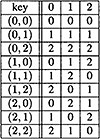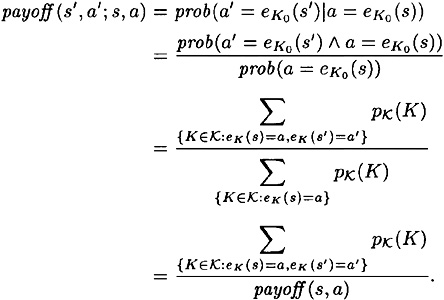Cryptography: Theory and Practice:Authentication Codes
 | Cryptography: Theory and Practice by Douglas Stinson CRC Press, CRC Press LLC ISBN: 0849385210 Pub Date: 03/17/95 |
| Previous | Table of Contents | Next |
10.2 Computing Deception Probabilities
In this section, we look at the computation of deception probabilities. We begin with a small example of an authentication code.
Example 10.1
Suppose

and

For each  and each
and each  , define
, define

It will be useful to study the authentication matrix, which tabulates all the values eij(s). For each key  and for each
and for each  , place the authentication tag eK(s) in row K and column s of a
, place the authentication tag eK(s) in row K and column s of a  matrix M. The array M is presented in Figure 10.3.
matrix M. The array M is presented in Figure 10.3.
Suppose that the key is chosen at random, i.e.,  for each
for each  . We do not specify the probability distribution
. We do not specify the probability distribution  since it turns out to be immaterial in this example.
since it turns out to be immaterial in this example.
Let’s first consider an impersonation attack. Oscar will pick a source state s, and attempt to guess the “correct” authentication tag. Denote by K0 the actual key being used (which is unknown to Oscar). Oscar will succeed in deceiving Bob if he guesses the tag  . However, for any
. However, for any  and
and  , it is easy to verify that there are exactly three (out of nine) authentication rules
, it is easy to verify that there are exactly three (out of nine) authentication rules  such that eK(s) = a. (In other words, each symbol occurs three times in each column of the authentication matrix.) Hence, it follows that Pd0 = 1/3.
such that eK(s) = a. (In other words, each symbol occurs three times in each column of the authentication matrix.) Hence, it follows that Pd0 = 1/3.

Figure 10.3 An authentication matrix
Substitution is a bit more complicated to analyze. As a specific case, suppose Oscar observes the message (0, 0) in the channel. This does give Oscar some information about the key: he now knows that

Now suppose Oscar replaces the message (0, 0) with the message (1, 1). Then, he will succeed in his deception if and only if K0 = (1, 0). The probability that K0 is the key is 1/3, since the key is known to be in the set {(0, 0), (1, 0), (2, 0)}.
A similar analysis can be done for any substitution that Oscar might make. In general, if Oscar observes the message (s, a), and replaces it with any message (s′, a′) where s′ ≠ s, then he deceives Bob with probability 1/3. We can see this as follows. Observation of (s, a) restricts the key to one of three possibilities. Then, for each choice of (s′, a′), there is one key (out of the three possible keys) under which a′ is the authentication tag for s′.
Let’s now discuss how to compute the deception probabilities in general. First, we consider Pd0. As above, let K0 denote the key chosen by Alice and Bob. For  and
and  , define payoff (s, a) to be the probability that Bob will accept the message (s, a) as being authentic. It is not difficult to see that
, define payoff (s, a) to be the probability that Bob will accept the message (s, a) as being authentic. It is not difficult to see that

That is, payoff (s, a) is computing by selecting the rows of the authentication matrix that have entry a in column s, and summing the probabilities of the corresponding keys.
In order to maximize his chance of success, Oscar will choose (s, a) such that payoff (s, a) is a maximum. Hence,

Note that Pd0 does not depend on the probability distribution  .
.
Pd1 is more difficult to compute, and it may depend on the probability distribution  . Let’s first consider the following problem: Suppose Oscar observes the message (s, a) in the channel. Oscar will substitute some (s′, a′) for (s, a), where s′ ≠ s. Hence, for
. Let’s first consider the following problem: Suppose Oscar observes the message (s, a) in the channel. Oscar will substitute some (s′, a′) for (s, a), where s′ ≠ s. Hence, for  , and
, and  , we define payoff (s′, a′; s, a) to be the probability that a substitution of (s, a) with (s′, a′) will succeed in deceiving Bob. Then we can compute the following:
, we define payoff (s′, a′; s, a) to be the probability that a substitution of (s, a) with (s′, a′) will succeed in deceiving Bob. Then we can compute the following:

The numerator of this fraction is found by selecting the rows of the authentication matrix that have the value a in column s and the value a′ in column s′, and summing the probabilities of the corresponding keys.
Since Oscar wants to maximize his chance of deceiving Bob, he will compute

The quantity ps,a denotes the probability that Oscar can deceive Bob with a substitution, given that (s, a) is the message observed in the channel.
Now, how do we compute the deception probability Pd1? Evidently, we have to compute a weighted average of the quantities Ps,a with respect to the probabilities  of observing messages (s, a) in the channel. That is, we calculate Pd1 to be
of observing messages (s, a) in the channel. That is, we calculate Pd1 to be


Figure 10.4 An authentication matrix
The probability distribution  is as follows:
is as follows:

In Example 10.1,

for all s, a, so Pd0 = 1/3. Also, it can be checked that

for all s, s′, a, a′, s ≠ s′. Hence, Pd1 = 1/3 for any probability distribution  . (In general, though, Pd1 will depend on
. (In general, though, Pd1 will depend on  .)
.)
Let’s look at the computation of Pd0 and Pd1 for a less “regular” example.
| Previous | Table of Contents | Next |
Copyright © CRC Press LLC
EAN: 2147483647
Pages: 133